CERN Accelerating science

Find below the answer to frequently asked questions. Should you not find the information you are looking for, do not hesitate to contact us .

Preparing for your visit
CERN visits are free of charge, whether they are guided tours, exhibitions, labs, science shows or public events. Do not pay any third parties who claim that CERN is charging them.
Only if you take part in a guided tour, as some tours may take place on both sides of the Swiss-French border.
Yes. A paid car park is available next to the Globe of Science and Innovation. The bus parking available before the car park is reserved for groups with a booking. More details on our dedicated page .
No, but CERN can be reached by public transport and taxi. CERN is located 5.5km away from Geneva airport and 9.4km from Geneva Cornavin train station. Those arriving at Geneva airport can get bus and tram ticket from the machine in the baggage collection area of the arrivals hall. For further details please click here .
Our Resources menu provides numerous resources for you to learn more about CERN before your visit.
French and English. Some of the team members also speak other languages.
Accessibility
Yes. There are seating areas in the exhibitions and you can borrow a wheelchair or a folding stool in the reception area upon availability. Click here for more information about accessibility .
While pets are not generally permitted on site, guide dogs for the visually impaired are welcome. Please inform the Reception personnel when you arrive. Click here for more information about accessibility
Families and individual visitors
Families, individual visitors and small groups (less than 12 visitors) do not require prior booking. Simply show up at Reception, register on out web app, exclusively available on site, and off you go. More information here .
Booking is not required for families and individual visitors. Access to exhibitions, science shows and films (when available) is free within capacity limits. Guided tours and lab workshops can only be booked on site. A dedicated page explains why .
Group bookings (12 visitors and more)
If the date you want cannot be selected, it means that we cannot take any more groups on this date.
CERN receives twice as many requests as it has places available , so you are advised to book your tour as early as possible. Group (12 visitors and more) booking are opened 9 monts in advance and slots fill up in days.
Some of the places visited on guided tours are a long way from the CERN Reception (up to 15 km away). It is therefore important to organise transport. CERN has a limited number of coaches/minibuses to transport visitors. If you have your own coach/minibus, we will use it during the tour to travel between the visit points. Please make sure that the driver is aware of this and is prepared to drive you. Please note that the use of private cars is not allowed. Only coaches/minibuses (with 20 to 50 seats) are allowed to bring tour parties onto our sites.
You can request for your group to have lunch in one of CERN’s on-site cafeterias at the registration time. This request has to be accepted by CERN Visits service as we have limited capacity. You will be informed quickly of the decision.
If you omitted to request for this option, please contact us and provide your group booking reference number.
If your request has been accepted, and about 2 weeks before your visit, CERN Visits Service will assign you the restaurant and the time which suits the best your programme. You will be informed of the restaurant and the time your group has been assigned to at your arrival at CERN Science Gateway reception.
Please note that it is not possible to change the restaurant nor the time assigned to your group. Refrain from contacting any CERN restaurants' management directly (unless instructed by us).
Cost for a meal in CERN restaurants vary from around 10 CHF to 20 CHF depending on the restaurant and the meal. Payments are possible in cash in CHF and EUR (but change is always returned in CHF) or by most credit/debit cards.
No. As the applicable laws differ from one country to another, CERN is unable to provide a standard risk assessment document. A medical service and fire brigade are based on the Meyrin site, and strict safety rules are in place to protect everyone working at or visiting CERN.
Connect to http://myguidedtours.cern.ch with your login, select the request and click on Cancel the visit in the Other actions menu at the top.
Please submit a request using the contact form , quoting the reference number of your request. This number can be found in the automated e mails that have been sent to you and on the myguidedtours.cern.ch website.
Only if you have requested a guided tour as the visitors will enter the CERN fenced sites.
Once your guided tour request has been approved, you will be given access to a form available on myguidedtours.cern.ch to provide details of all the members of your party (first name, last name, nationality, date and place of birth).
If you have not requested a guided tour, the list of visitors is not required.
Make sure you enter only unaccented Latin characters, as shown in the machine-readable part of your identity document.
No. You can save the form and come back later to enter additional information. All visitors' details must be provided within 48 hours in the case of individual guided tours or at least 21 days before the guided tour in the case of group guided tours, otherwise visitors whose details are incomplete will be removed from the tour booking.
Yes, you are welcome to inform us of any changes, up to one day before the guided tour. No updates are possible on the day before the guided tour as this is when we need to print visitors' cards. You can inform the Reception staff of any last-minute changes when you arrive.
As soon as you arrive at the CERN Reception, please inform us of any last-minute changes. You will be requested to provide details of all visitors whose information has changed or who are not attending. Please note that the time needed to provide this information may reduce the duration of your guided tour. You are therefore advised to inform us of any changes online, up to one day before the guided tour.
No. Only the number of visitors registered on myguidedtours.cern.ch will be allowed to take part in the guided tour. Any visitors who have not been registered may visit the permanent exhibitions during the guided tour.
This information is not mandatory before your arrival, but you will have to provide it when you arrive at the CERN Reception at the latest. Make sure that you have this information with you.
No. The CERN logo is the property of CERN, and its use on any item produced by an external organisation is not permitted under any circumstances, including in the context of a school visit. However, the use of phrases such as “Visit to CERN, Geneva, Switzerland” is acceptable.
Yes, but availability is limited. School groups visiting CERN may apply to stay in the CERN hostel if all the members of the group are at least 16 years of age and have already been registered for a guided tour by the Visits Service. Teachers will be responsible for the group throughout the stay and must remain in the hostel with the pupils at all times. One teacher is required for every 10 pupils. Bookings cannot be made more than 90 days in advance of the tour and are limited to a maximum of three nights. Please note that no bookings are possible in June, July, August or September.
For all hostel bookings, please contact: CERN Hostel once your guided tour has been confirmed by the Visits Service.
Many school groups use the Geneva youth hostel . You can also find hotels nearby on Google Maps .
On-site services
Yes, CERN provides 321 lockers for free. Luggage is not permitted in our premises. All lockers must be emptied at 17.30 at the latest. A limited number of lockers can contain up to cabin-size luggage. Larger items are not allowed at CERN. We invite you to leave larger items in your coach or at your hotel. Luggage storage facilities are also available at Geneva airport and the Cornavin train station .
Yes. The Big Bang Café welcomes you from 08.00 to 17.00. Selected groups with a booking will also be allowed to access the CERN restaurants inside fenced domain.
Yes. Free public Wi-Fi is available in and around CERN’s main buildings. Connect to CERN-Visitors Wi-Fi, and open a web browser to access our exclusive web app to register and get access to CERN Science Gateway. Should you need to access Internet, you will have to register your phone fully with a code.
Yes, the souvenir shop in the Reception area sells books, educational items, games, clothes and gifts. More information can be found here . Please note that the shop and reception close at 18:00, so set aside enough time for your shopping.
Depending on the restaurant assigned and menu chosen, a lunch cost between 15 CHF and 30 CHF. Swiss franc and euro banknotes are accepted. Change is always given in Swiss francs. CERN Restaurants accept all major credit and debit cards.
Not publicly accessible. Only groups granted restaurant access will be able to use the ATMs inside the fenced part of the site. The CERN shop accepts most credits cards .
Yes, most cards are accepted . You can also pay in cash using Swiss francs or euro notes. However, change is given in Swiss francs only.
Exhibitions
Yes, like all outreach activities at CERN, exhibitions are accessible free of charge.
Only if you are a group (12 visitors and more). Group bookings are available here .
For individual visitors, families and small groups, an onsite registration on our web app exclusively accessible onsite is the only registration needed to access freely the exhibitions and other activies. See more here .
The exhibition welcomes visitors of all ages, although it is best enjoyed by ages 8+.
The exhibitions are designed to be self-visited. But guides, recognisable with their red jacket, will be present in exhibiitions should you have a question. Don’t hesitate ask them.
Guided tours
Tours are conducted exclusively by members or former members of the CERN personnel, who give tours on a voluntary basis.
Tours last between one and a half hour (tours for individuals and families) and up to three hours (tours for groups). It is not possible to leave a tour before it ends.
Underground tours are extremely rare and limited to smaller groups. The LHC tunnel is never accessible to visitors. Only the experiment caverns can be visited during LHC shutdowns. But there are plenty of interesting places to visit above ground! The final tour programme is decided at the last minute to take operational and safety constraints into account and cannot be confirmed in advance.
Find our more on our dedicated page .
Yes, CERN has no secrets and you can photograph or film anything you wish throughout your visit, as long as you do not violate the privacy rights of individuals.

Visiting CERN – 11 Tips That Will Help You Make the Most of the Hadron Collider Tour
- By Traveling Anne
- February 28, 2024
- In Europe Travel Destinations
As promised in my French Alps trip report , here's a more detailed review of our excellent visit to CERN, near Geneva, Switzerland. There are several tips I want to share as well, about what we did right and what we could have done better. Read through if you are thinking of visiting CERN so you can make the most of your time there.
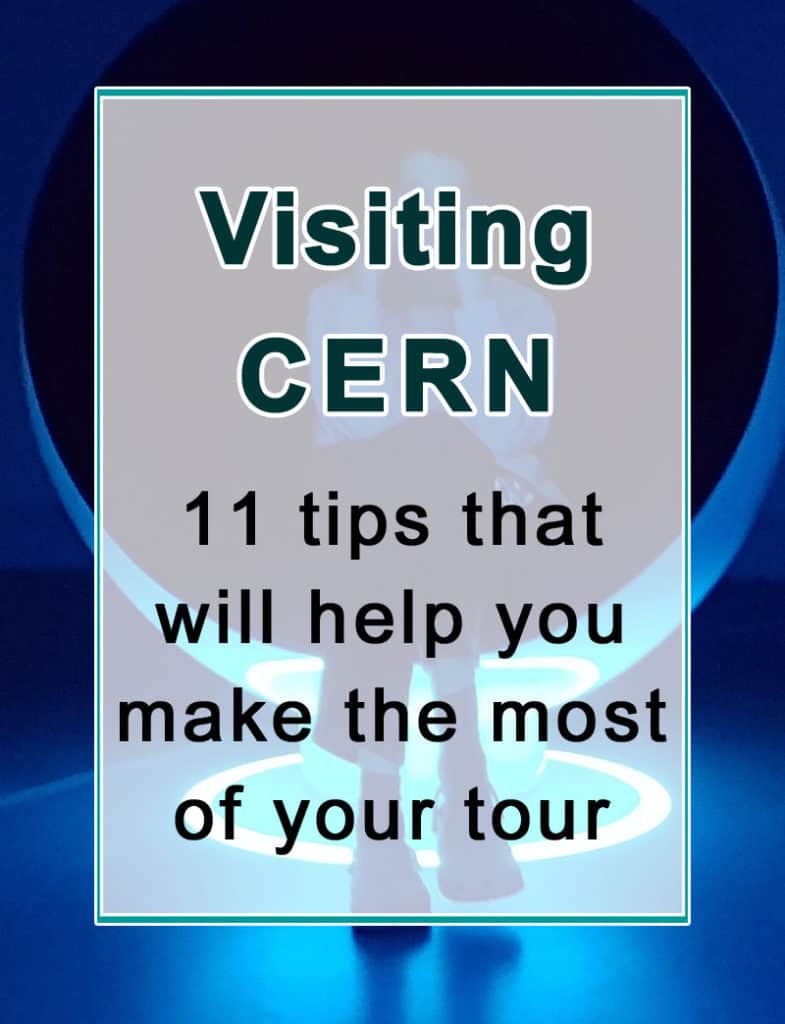
What is CERN all about?
You may occasionally see the name Cern, not as an acronym. It's not the name of a town or a village though. Rather, it's an acronym for a long title in French: Conseil Européen pour la Recherche Nucléaire. Which translates into: The European council for nuclear research. I will be using CERN and Cern interchangeably throughout this post because these days it's both a place and a concept.
The council was established back in 1954 in an effort to promote scientific collaboration between the nations of Europe, at the time still licking their proverbial and literal wounds of the second world war. They were allocated an area near Geneva where the CERN project was established on (and under) the ground. The name of the initiative has since changed into the European Organization for Nuclear Research but it's still known as Cern (and not as EONR, thankfully).
There have been many amazing discoveries made in CERN over the years, some of which have lead to nobel prizes in physics and chemistry. It is best known for its huge particle collider, aka the Hadron Collider.
There are several underground looped tunnels where sub-atomic particles are accelerated in phases and then enter the largest loop of all: the Hadron collider. Beams of particles are made to smash into one another at specific stations within the collider and the results are recorded to be further analyzed by scientists across the globe. It really is an amazing feat of human ingenuity. That makes visiting CERN an uplifting experience for all, not just science buffs.
Visiting CERN: Can you actually visit the Hadron Collider?
Yes and no. You can visit Cern and be above the collider. The main road which runs through the main complex that surrounds the main research station - known as The Atlas Project - is open to the public. There is a visitors center there which includes two permanent exhibitions -
Microcosm - The story of collider and how it works, as well as a little bit about what life in Cern is for the 10,000+ scientists and engineers who work there.
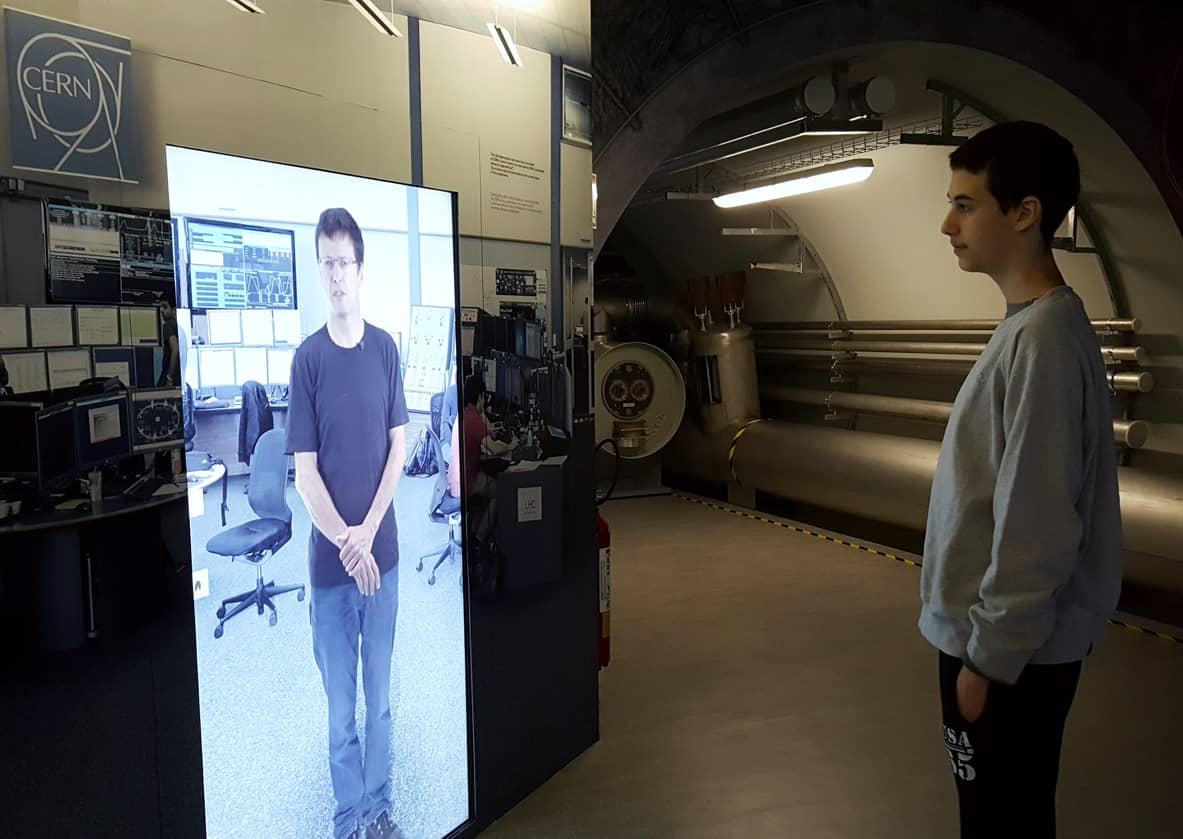
In addition to the exhibitions, there is a guided tour that takes you "behind the scenes". I have seen photos of people wearing helmets and looking at what appears to be part of the collider. During our own visit, the guide explained that they do not take visitors down to the collider because the levels of radiation there are not safe.
So, no, we did not get to see the actual collider. We did get to see several models and hear a LOT about it. Considering its actual size (about 27 kilometers long!) I don't see how you can actually "see" more than a very small part of it going underground. Either way, you can't see it "working". According to our guide (who was also a physicist and a shift leader at Cern) there's not much to be seen. The particle beam is silent and invisible.
Who should be visiting CERN?
Cern is a must-visit for anyone who loves science and specifically physics. The exhibitions are thorough and our guide was a professional physicist who could answer all of the questions thrown at him by our group's science buffs.
Even if you're not into physics, I think the tour would be enjoyable. The exhibitions are interactive and exciting and there is something very moving about the entire project: European nations working together to promote science and peace.
And finally...
11 quick tips that will help you make the most of your visit
1. book the tour.
The tour is entirely free and it gets you that unique "behind the scenes" look into the project. Our guide was fascinating and it was really cool to walk past these gates:
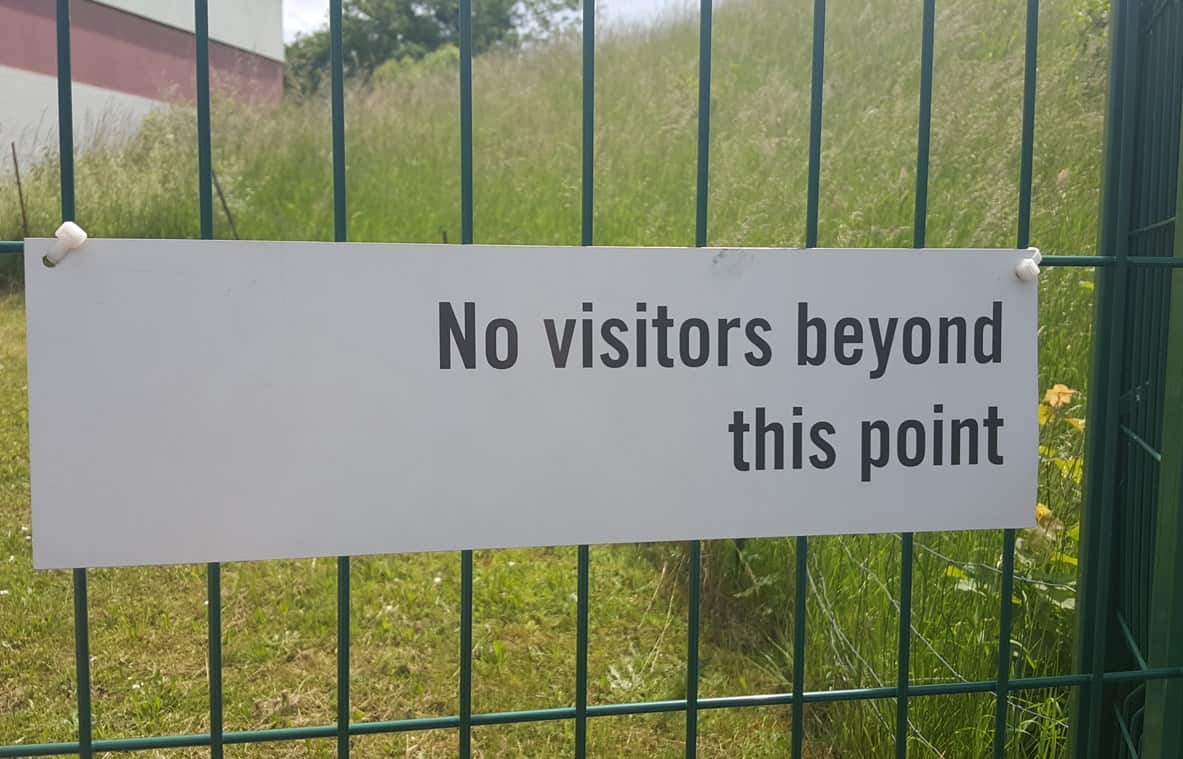
The tour also takes you to a special exhibition with a 20 minutes long multimedia show projected on the walls and on the equipment around you. Really cool and great fun for kids.
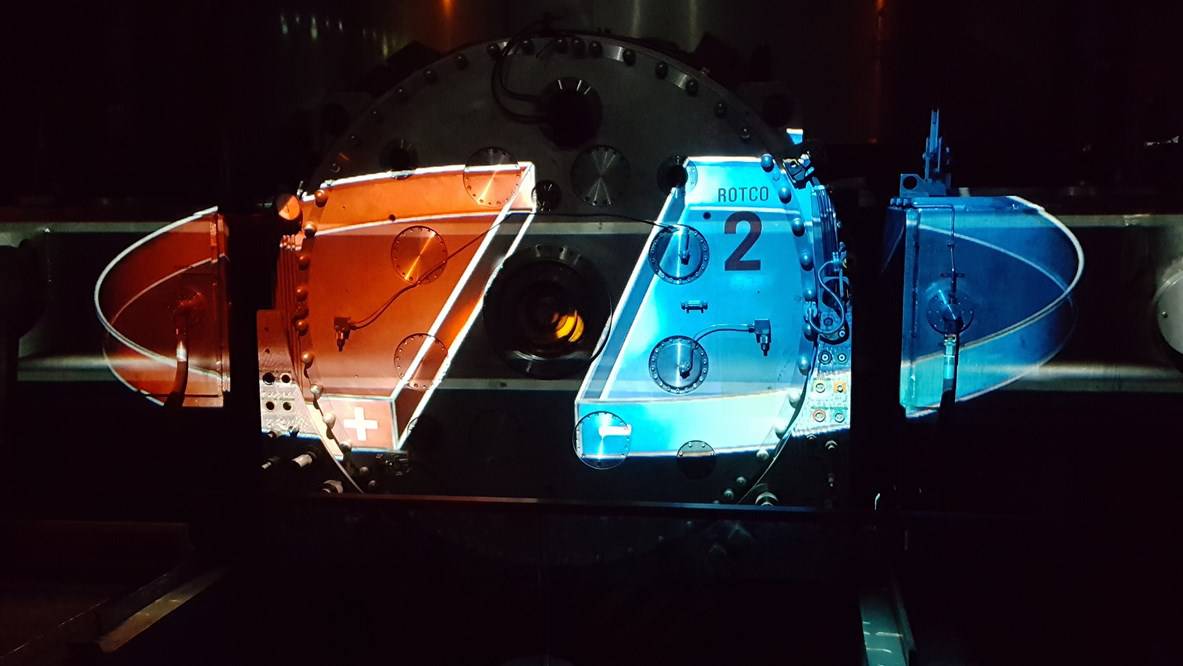
2. Guided tours fill up really fast
They open up for registration 15 days ahead of the date, in the morning (Switzerland time) and as far as I could see, registration closes within a couple of hours. They re-open three days ahead of the date for latecomers and I guess if there are no-shows, you can try and wriggle your way into a group.
3. Be prepared to take pictures on the guided tour
With all the fences and guards, we thought they may ask us not to take pictures. Quite the opposite. Our guide said they want us to take as many pictures as possible! Keep your camera ready during the tour because photo-ops pop up literally as you walk around while visiting CERN. Like taking pictures of street signs -
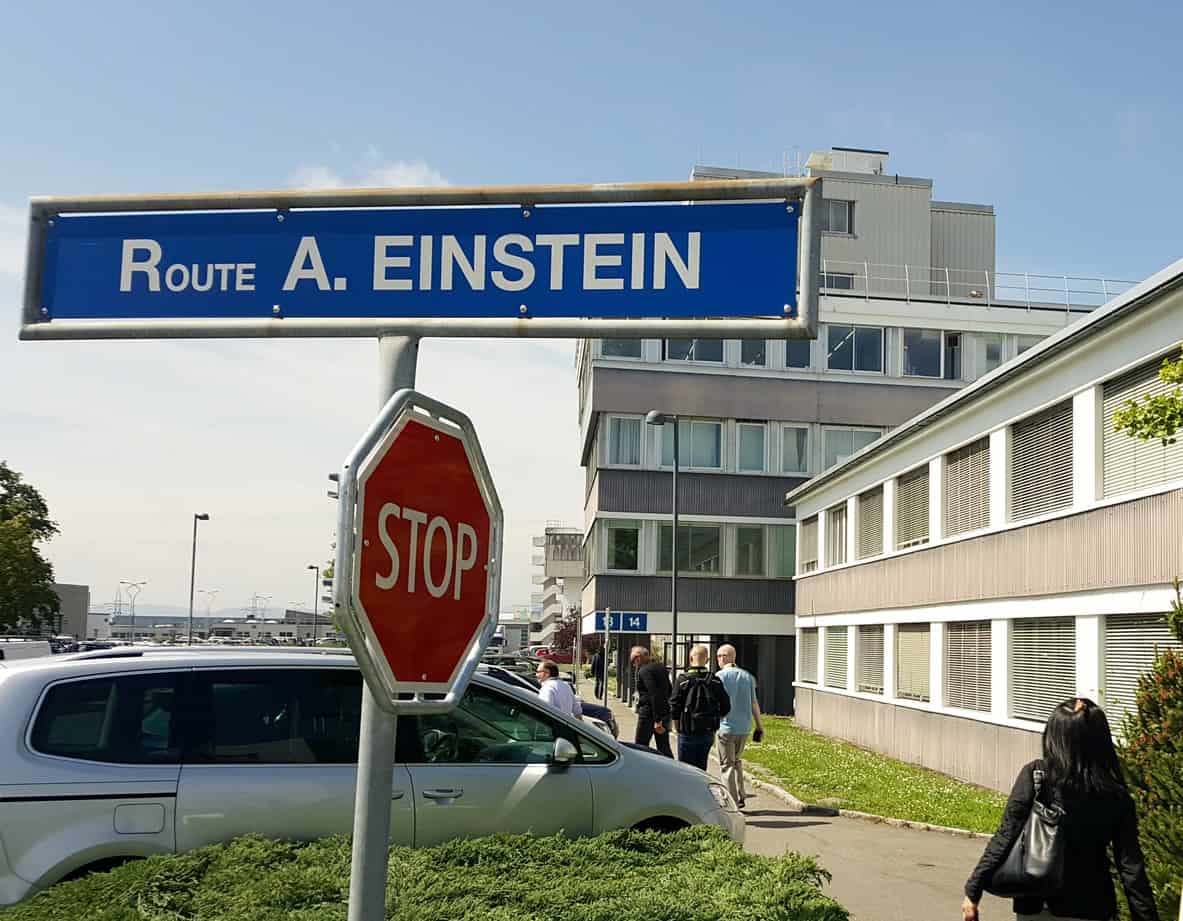
4. Be prepared for a long visit
This isn't a place you can run through in 20 minutes. The exhibitions alone are well-worth 1-2 hours (possibly longer if you are interested in physics). The tour takes up another two hours of your time. All in all, three hours is the bare minimum. We spent five hours at Cern and could have stayed for longer if we had more time.
5. Check for opening hours
There are different opening hours for the exhibitions. The visitors center and the Microcosm exhibition open at 8:30. The Universe Of Particles opens at 10. There are several time slots for the guided tours. Check your times and make sure you allocate at least an hour for each exhibition and 2 hours for the tour (including showing up 15 minutes in advance to get your badges). The good news is that everything is close-by, so it only takes a couple of minutes to get from one exhibition to the other.
6. Bring your own food
Google maps knows of a couple of cafeterias at Cern which we had planned on checking out. Nothing quite like enjoying a croissant while rubbing shoulders with a local version of Sheldon Cooper, right? I thought this would add to our "Visiting CERN" experience.
As it happens, these cafeterias are out of bounds for us mere mortals. The only way to get a coffee or any food is at the local gas station. It's very close to the visitors center, so not a long walk, but the prices are quite Swiss (i.e. expensive!) and the food quality is nothing to write home about - basically what you'd expect to find in a gas station store. They do have a really cool espresso machine that generates so much steam while making your coffee, you might think they're running it through the Hadron collider itself!
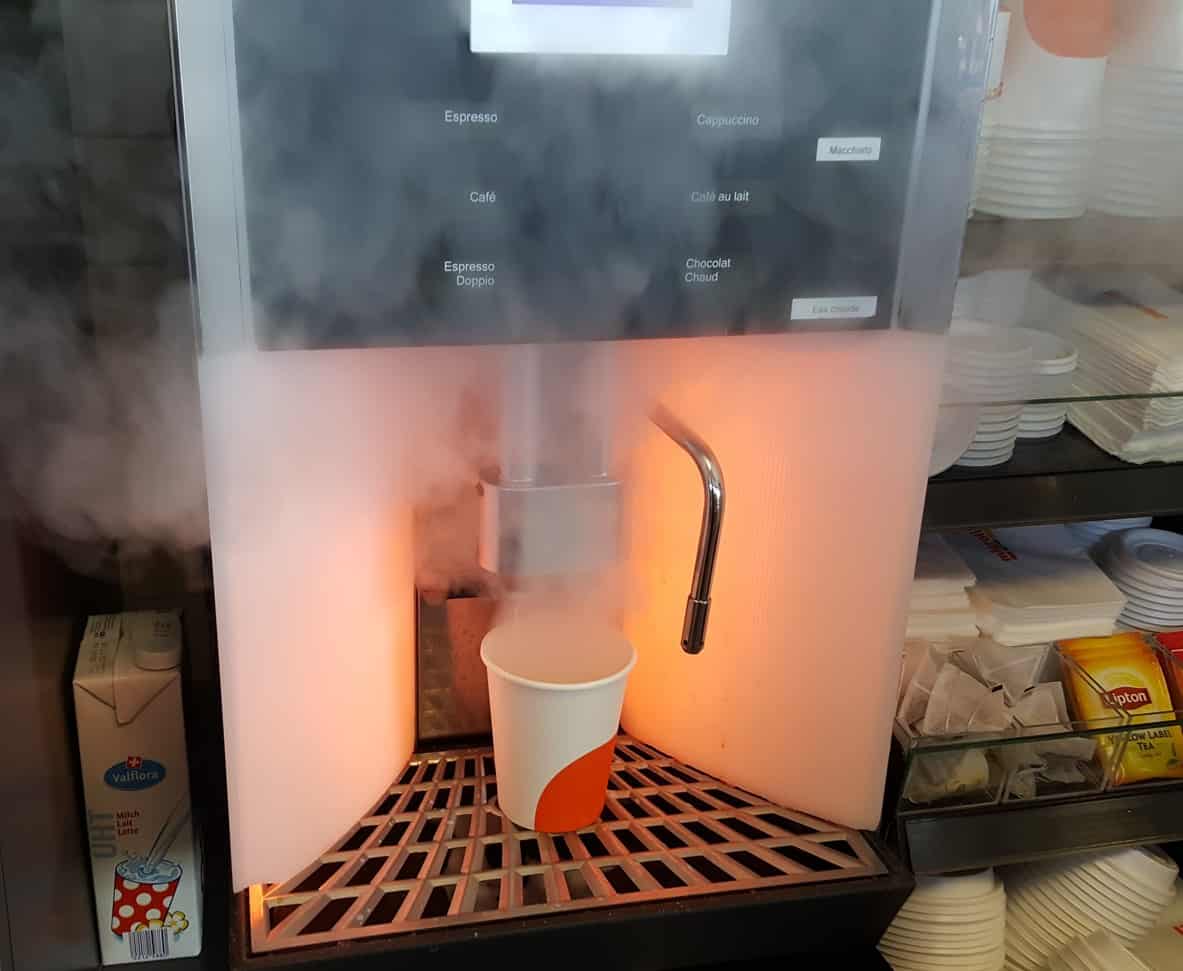
7. Eat and drink before the tour
If you didn't bring anything to eat, grab something - anything - at that gas station. The tour isn't short and you can't eat or drink anywhere during the tour. You also can't leave the tour once you started because you have to be accompanied by the guide when inside Cern. So -especially if you're traveling with kids - make sure everyone is well fed before you start the tour.
8. Wear comfortable shoes and dress according to the weather
The guided tour has you walking about one mile on foot. Not too bad but enough to be more enjoyable with comfortable shoes. You will be walking outside for a short bit as well, so if it looks like it might rain, gear up accordingly.
9. Park near the big dome
There's plenty of parking, or at least there was on the day of our visit, but you can't just park anywhere. The best place for you to park would be next to the big brown dome. Just east of the dome, towards the Swiss side of Cern, there is a big parking lot that's free to park at.
10. Watch a movie about the project before visiting CERN
I wanted to get our kids acquainted with Cern before we came and to be honest, I didn't know a whole lot about it other than that's where they had recently discovered the Boson-Higgs and that people were afraid they might create a black hole in the process, swallowing up the entire earth (which turned up to be a slight exaggeration).
The movie we watched was available on Netflix. It's called "Particle Fever" and you can buy or rent it on Amazon too .
11. Don't worry about the language barrier
Cern is technically in both Switzerland and France (the border runs in the middle) but everyone there speaks English. More importantly, the exhibitions all have English labels or English narration options and the guided tour is available in English. That's not something you typically find in French science (or other) museums so it's worth mentioning here.
And one last tip...
12. Have fun!
Visiting CERN is fun! There's a lot of humor to be found in the exhibitions. Lots of red buttons to push and see whether you actually create a black hole that can swallow up the entire earth. It hasn't happened to us but who knows, you might just get lucky!
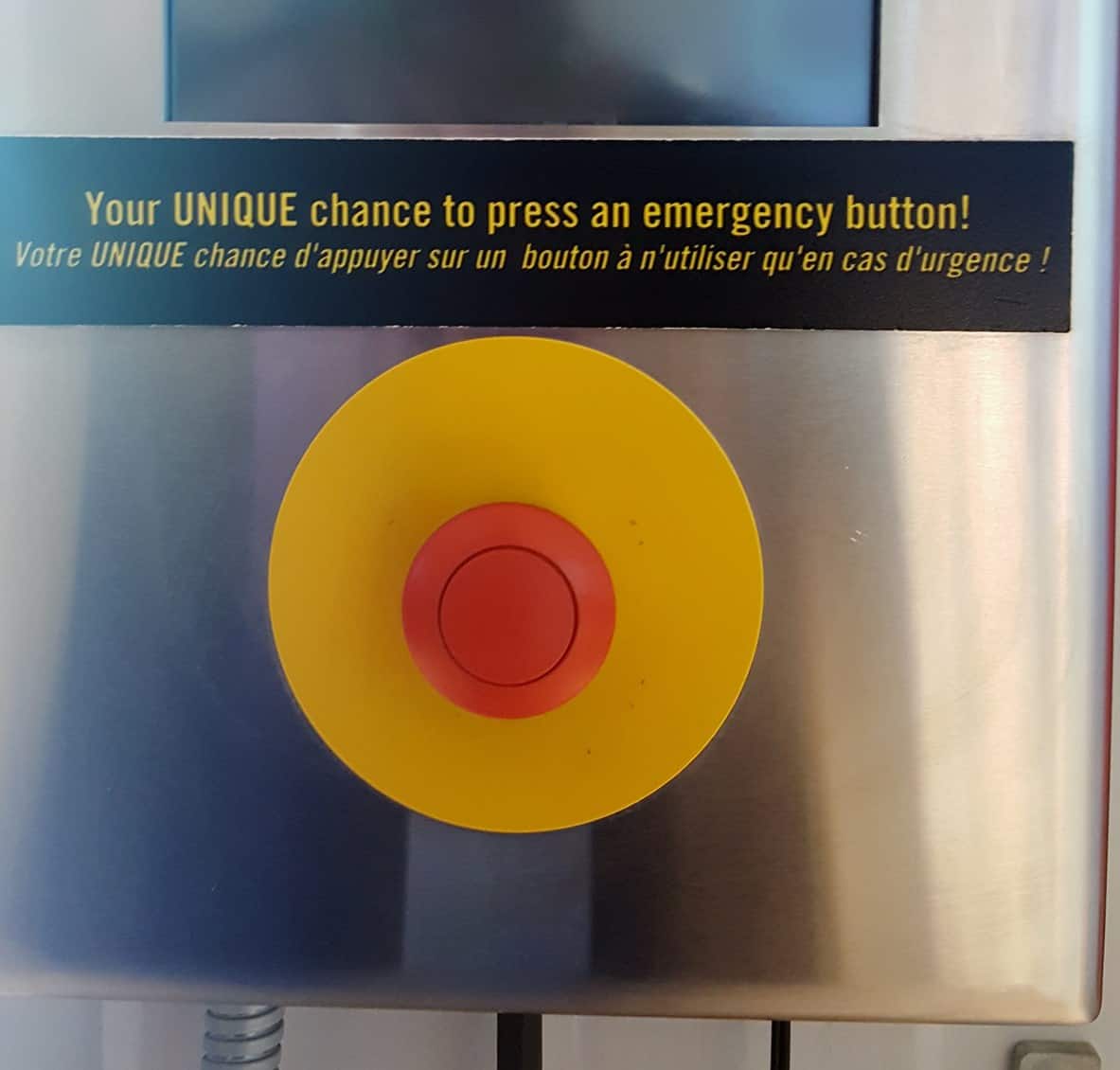
Have you ever visited Cern? Got any tips to add? Please share those in the comments section below. You can also leave me questions about visiting CERN and I'll try and give you the best answer I can.
Awesome tips i will give 5 out of 5 stars for these tips i totally loved it.❤
Thank you so much, Asher!
Is it possible to use photo in the chapter 3? I am writing a post for students and schoolchildren and I need photo like that.
Check your email 🙂 I sent you an email with a couple of questions so we can take it from there.
Thanks for the info. Our rental auto does not permit us to drive into Switzerland. Do you know if there is ample free car parking on the French side and we can just walk 5 minutes to Reception?
Hi Paul, I couldn’t find the answer on their website so I emailed Francois Briard, head of CERN’s Visits center who has visited and commented on this post before 🙂 He was very prompt and helpful but unfortunately the answer is that there is no available parking space on the French side that’s within walking distance from the visitors center. He added that you shouldn’t count on parking by the side of the road because French commuters have these filled up by 8AM. His suggestion was to get bus Y line from Saint-Genis-Pouilly and that can drop you at the CERN bus stop. I hope this helps! Enjoy your visit to CERN!
Thanks for the very accurate and useful tips! Our website has been rebranded a bit giving even more information.
François, head of CERN’s Visits Service 😉
Thanks for stopping by and leaving a comment, François! I’m glad you liked my post!
Leave a Reply Cancel Reply
Your email address will not be published. Required fields are marked *
Name *
Email *
Add Comment *
Post Comment

Top ways to experience nearby attractions

Most Recent: Reviews ordered by most recent publish date in descending order.
Detailed Reviews: Reviews ordered by recency and descriptiveness of user-identified themes such as waiting time, length of visit, general tips, and location information.
CERN: All You Need to Know BEFORE You Go (with Photos)
- Tue - Sun 09:00 - 17:00
- (4.74 mi) Swiss Luxury Apartments
- (4.82 mi) Hotel d'Angleterre
- (1.40 mi) Ibis St Genis Pouilly Geneve
- (4.91 mi) Hôtel Les Armures
- (3.10 mi) Jiva Hill Resort
- (0.01 mi) Big Bang Café
- (0.21 mi) Nirvana
- (0.23 mi) Restaurant Le Smash
- (0.41 mi) Restaurant Don Pedro 1951
- (0.41 mi) Da Vinci
- (0.01 mi) CERN Science Gateway
- (0.83 mi) Alpytransfers
- (4.66 mi) Local Flavours Tours
- (4.36 mi) Trip Trap Escape
- (4.49 mi) La Traque

Is This the Nerdiest Thing You Can Do in Switzerland?
Cern, the nuclear physics science center where the world wide web was invented and the higgs boson was discovered, is open to the public for free. and it’s awesome..
- Copy Link copied

The Globe of Science and Innovation houses an exhibition, and the ribbon-like steel sculpture in front is laser-cut with 396 great physics discoveries through the ages.
Photo by Billie Cohen
Switzerland is known to travelers for many good reasons: chocolate, cheese, mountains, lakes. But “world’s largest particle physics laboratory” isn’t really at the top of their minds. Nor is the fact that they can visit that lab for free, just 25 minutes outside of Geneva. In fact, I’d argue that a visit to CERN is one of the coolest—and, admittedly, nerdiest—things you can do in Switzerland.
What is CERN?
CERN ( Conseil Européen pour la Recherche Nucléaire in French, or European Council for Nuclear Research) is an internationally run science center that straddles the border of Switzerland and France.
This place is a pretty big deal: It’s where the world wide web was invented in 1989, where antimatter was discovered, and where the so-called God particle (aka the Higgs boson) was identified in 2012, validating scientists’ model for how the subatomic world works. As a result, a lot of what we know about atoms and the universe—and I guess, cat memes—can be attributed to the work done here.
For nerds of various stripes, this is all major—as is the fact that CERN’s campus is the home of the Large Hadron Collider particle accelerator, a 16.8-mile underground track where the world’s most brilliant minds smash tiny, speeding particles together to see what they can learn.
“What astronomers do with telescopes, we do with particle detectors,” said CERN’s head of media relations, Arnaud Marsollier, in a webinar last week. “When we look at the universe, we understand only 5 percent of it. The other 95 percent, which is dark matter or dark energy, we don’t know what it is. We know it’s there’s—we have proof of that—but we don’t know what it is. So this is exactly why we are experimenting further.”
CERN is also a rare example of successful international collaboration: A group of 23 member states manage CERN today , and more than 12,000 scientists from 110 countries use the facilities and research developed here.

The Large Hadron Collider is the most powerful particle accelerator ever built; it’s made of a 27-kilometer-long ring of superconducting magnets in a tunnel 100 meters underground at CERN.
Courtesy of CERN
What kind of nuclear research is going on here?
The word nuclear in CERN’s title doesn’t have to do with nuclear warheads or weaponry at all. In fact, CERN was founded after World War II by a consortium of European countries with the mission to bring scientists together to use their intelligence for peace rather than bombs. As CERN’s convention states : “The Organization shall have no concern with work for military requirements and the results of its experimental and theoretical work shall be published or otherwise made generally available.”
So why is the word nuclear in CERN’s title then? Because at the time of CERN’s founding, physics research was focused on understanding the inside of atoms—or the nucleus—and it was called “nuclear.” Today, that area of study is known as particle research. CERN develops technologies in three areas: particle accelerators, particle detectors, and computing. And the scientists here aim to answer questions including:
- What is the unknown 95 percent of the mass and energy of the universe?
- Why is gravity so weak compared to other forces?
- Why is the universe made only of matter, with hardly any antimatter?
- Is there only one Higgs boson, and does it behave exactly as expected?
In the process, their efforts have concrete, real-world applications for daily life. For example, accelerator technologies are used in cancer radiotherapy, and other tech helps with innovations in 3D color X-ray imaging and PET-scan imaging and diagnostics.
Is it safe to visit? Yes. However, over the years, some have raised concerns about the Large Hadron Collider (LHC) creating microscopic black holes (it can’t) or emitting cosmic rays. So the center’s website offers detailed explanations to assuage any fears, explaining, for example, “The Universe as a whole conducts more than 10 million million LHC-like experiments per second. The possibility of any dangerous consequences contradicts what astronomers see—stars and galaxies still exist.”

Renzo Piano designed CERN’s new Science Gateway; its tubular structure references the track of the Large Hadron Collider, and the forest planted around it suggests the connection between science and nature.
What can visitors can do and see at CERN?
The most innovative thing about this manicured, sprawling science mini-town is that everything the scientists do here is completely public. All of their research is accessible to everyone—and so is the campus. Free guided tours are offered in English and French and led by CERN staffers, such as physicists, engineers, and technicians. On the tours, guests can view the facility’s first particle accelerator, the synchrocyclotron, installed in 1957, and also peep into the control room that oversees the ATLAS experiment, which helped identify the Higgs boson in 2012. When I visited, my tour guide proudly stated, “Nothing is hidden.”
This month, CERN added another way for the public to engage with its work: a new exhibition and education center, dubbed the Science Gateway , designed by starchitect Renzo Piano. (He’s also responsible for New York’s new Whitney Museum, Paris’s Centre Pompidou, London’s Shard, and another Swiss beauty, the Zentrum Paul Klee in Bern.)
“This will be a place where people meet: kids, students, adults, teachers and scientists, everybody attracted by the exploration of the Universe, from the infinitely vast to the infinitely small. It is a bridge, in both a metaphorical and a real sense. This building is fed by the energy of the Sun, landed in the middle of a newly grown forest,” Piano said in a press release about the opening.
On the outside, the building looks like two parallel tubes connected by a bridge—a nod to CERN’s accelerators—and is carbon neutral, thanks to 4,000 square meters of solar panels. More than 400 trees were also planted around it, creating the effect that it’s floating above a forest.
Inside, the Science Gateway has three exhibitions (Discover CERN, Out Universe, and Quantum World), and it hosts science shows in a theater and hands-on workshops (for school groups as well as for individual visitors). There are also public events, like the upcoming Dark Matter Day with a talk by Nobel Prize–winning astronomer Michel Mayor (November 3) and a live performance of The Infinite Monkey Cage podcast featuring physicist Brian Cox and comedian Robin Ince (January 12).

Visitors can see CERN’s first particle accelerator, the synchrocyclotron, installed back in 1957.
How to visit
CERN is a 25-minute tram ride from Geneva’s city center, and some hotels may even offer free transport cards.
The Science Gateway ‘s exhibitions are open Tuesday–Sunday 9 a.m.–5 p.m. (reception opens at 8 a.m.). Tours can be booked at the Science Gateway on a first-come, first-served basis.



Top ways to experience nearby attractions

Most Recent: Reviews ordered by most recent publish date in descending order.
Detailed Reviews: Reviews ordered by recency and descriptiveness of user-identified themes such as wait time, length of visit, general tips, and location information.

CERN - All You Need to Know BEFORE You Go (2024)
- Tue - Sun 9:00 AM - 5:00 PM
- (4.74 mi) Swiss Luxury Apartments
- (4.82 mi) Hotel d'Angleterre
- (1.40 mi) Ibis St Genis Pouilly Geneve
- (4.91 mi) Hôtel Les Armures
- (3.10 mi) Jiva Hill Resort
- (0.01 mi) Big Bang Café
- (0.21 mi) Nirvana
- (0.23 mi) Restaurant Le Smash
- (0.41 mi) Restaurant Don Pedro 1951
- (0.41 mi) Da Vinci
- (0.01 mi) CERN Science Gateway
- (0.83 mi) Alpytransfers
- (4.66 mi) Local Flavours Tours
- (4.36 mi) Trip Trap Escape
- (4.49 mi) La Traque
CERN Accelerating science

Scroll down to discover what CERN Science Gateway has to offer !
Meet our guides: Dominique
Science shows, exhibitions, quantum world, our universe, discover cern, more activities.
Depending on the day's programme
Lab workshops
Guided tours, plan your visit, accessibility, getting here, opening hours, public events.
Public events at CERN are organised with the support of the CERN & Society Foundation
CineGlobe 2024 - Opening night: Universe in a Grain of Sand
Cineglobe 2024 - cinéma improv, cineglobe 2024 - table ronde : ce que l’art amène à la science, cineglobe 2024 - immersive art-science night, cineglobe 2024 - awards ceremony, cern70 public event: cern - an extraordinary human endeavour, cern70 public event: the case of the (still) mysterious universe, cern70 public event: exploring farther - machines for new knowledge, cern70 official ceremony: inspiring the future.
The CERN Science Gateway project is made possible thanks to the generous support of its donors. Click below to discover them all.

- Public Transport
Geneva.info » Sights » CERN
Guided Tours For a tourist it is possible to book a tour to ATLAS. Guided tours are ran by local employees who deeply understand the topic, for free. Tour last about 1 hour. It is mandatory to register for a guided tour more than a week in advance. You only need to find a guide and provide Your name, date of birth. Tours are usually for free. However, Atlas is closed since October 2014 for about 2 years construction. Next to Atlas is also an exhibition/museum - big wooden Globe; another exhibition on the other side of CERN is Microcosmos.
Restaurants There are restaurants 1, 2, 3 and Indian restaurant inside the CERN. Public has no access inside the CERN, only when being accompanied by a local employee. There are several restaurants, cafes and parking lots around.
Sports Bike trail goes 50km around (and above) the LHC circle.
- Hotels in Geneva
- Entertainment
- Restaurants
Geneva Hotel Booking
Facts about Geneva :
Jet d'Eau Fountain
Tips | Nightlife
What's on Geneva Fêtes De Genève 16th July - 09th August
Accommodation
Back To Top
CERN Accelerating science

Collaboration Site | Physics Results

ATLAS Visits
How to visit in person.
To schedule an onsite visit to the ATLAS experiment, please contact the CERN Visits Service .
The ATLAS Visitor Center has a permanent exhibit with interactive screens outside the Control Room and a 3D movie which explains how the detector works and why the collaboration pursues its quest for fundamental knowledge. CERN also has two permanent exhibitions Universe of Particles and Microcosm that provide unique experiences in understanding the secrets of matter and exploring the mysteries in our universe.

ATLAS Virtual Visits
How to visit remotely.
An ATLAS Virtual Visit connects a classroom, exhibition or other public venues with scientists at the experiment using web-based video conferencing. It is a chance for you to have a conversation with the scientists working on ATLAS.
Group Visits
For groups of at least 10 visitors, you can schedule a Virtual Visit by completing this form.
Open Visits
We also schedule periodic visits for individuals or small groups to join. You can see a list of upcoming Open Virtual Visits here . Select the one you want and register.

ATLAS Virtual Tours
Explore atlas virtually.
Take a virtual tour around the ATLAS detector in the cavern, located around 80 meters below ground at interaction point 1 of the LHC. Alternatively, walk around the detector and control room using Google's street view .
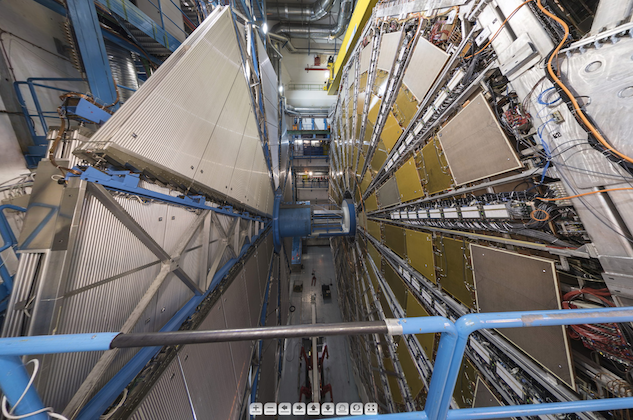
CERN Accelerating science

CERN Accelerating science

CERN has two main sites, one in France and the other in Switzerland. The visitor reception can be found at the Meyrin site in Switzerland. For postal addresses and other contact information, please visit our contact page .
For information about goods reception, please visit the Site and Civil Engineering (SCE) department's website .
Location of the visitor reception:
How to get to CERN
From geneva international airport at cointrin.
- Taxi: approximately 35 CHF.
- Public transport : take bus 23 , 28 or 57 and get off at "Blandonnet" and then catch tram 18 or bus 68 to the final stop "CERN". See the TPG web site for full details.
From Geneva railway station at Cornavin ( Gare Cornavin )
Public transport : take tram 18 to "CERN", which is the final stop. Ticket costs 3 CHF (Ticket "Tout Genève" on the ticket machine). See the TPG web site for full details.
GPS location
Address: 1, Esplanade des Particules, Meyrin, Switzerland Reception: Lat: 46.233058, Long: 6.055692
From the Swiss side
Follow "Aeroport", "Lyon" or "Meyrin". When in Meyrin head for "St. Genis" (which is just across the border in France). Before you get to St. Genis, CERN is on the left hand side of the "Route de Meyrin", just before the border crossing.
From the French side
Follow "Gex" or "St. Genis". When in St. Genis head for the border. CERN is on your right hand side immediately after the border crossing.
Once you get here…
- Registration service
- Find a building at CERN
Thank you for visiting nature.com. You are using a browser version with limited support for CSS. To obtain the best experience, we recommend you use a more up to date browser (or turn off compatibility mode in Internet Explorer). In the meantime, to ensure continued support, we are displaying the site without styles and JavaScript.
- View all journals
- Explore content
- About the journal
- Publish with us
- Sign up for alerts
- 17 April 2024
CERN’s impact goes way beyond tiny particles
- Nikki Forrester 0
Nikki Forrester is a science journalist based in Davis, West Virginia.
You can also search for this author in PubMed Google Scholar
You have full access to this article via your institution.
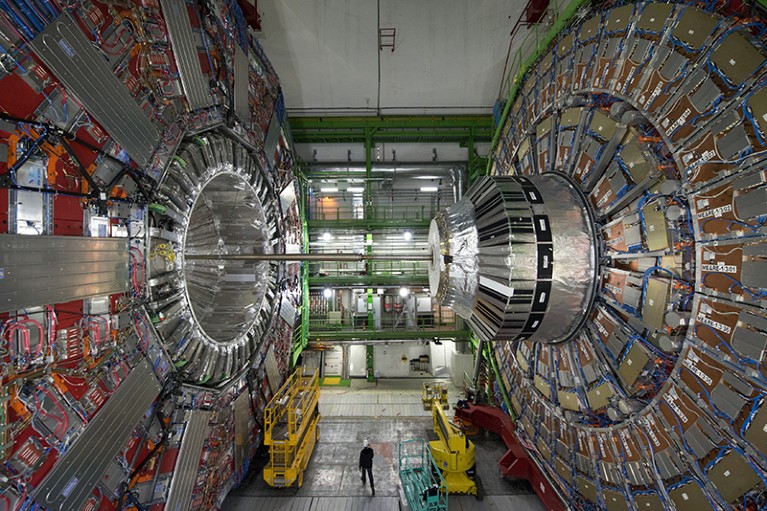
The Compact Muon Solenoid (CMS) detector enabled the discovery of the Higgs boson at CERN, Europe’s particle-physics lab near Geneva. Credit: Richard Juilliart/AFP via Getty
Roughly 100 metres underground, in a tunnel that crosses the border between Switzerland and France, lies the largest machine ever built. The Large Hadron Collider (LHC) compresses and collides tiny bits of matter to recreate the fundamental particles that appeared just one-trillionth of a second after the Universe was created.
It’s all part of a day’s work at CERN, Europe’s particle-physics laboratory near Geneva, which is home to the LHC. The lab, which celebrates its 70th anniversary this year, continues to attract scientists who are eager to uncover the nature of particles that comprise matter. Along with more than 2,600 staff members and 900 fellows, CERN hosted nearly 12,000 visiting scientists from 82 countries in 2022. According to indexed papers on the Web of Science database, the researchers publish, on average, around 1,000 papers each year that explore the origin of the Universe, antimatter, dark matter, supersymmetry and beyond. And their ranks include eminent scientists such as Tim Berners-Lee, credited with inventing the World Wide Web, and physicist Peter Higgs, who died on 8 April.
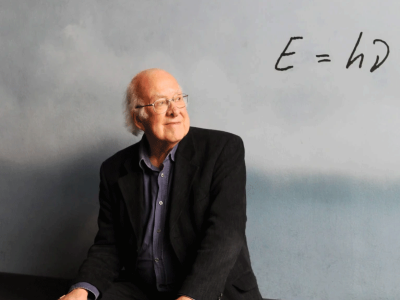
Peter Higgs obituary: physicist who predicted boson that explains why particles have mass
“Particle physics is basically exploring back in time,” says Alain Blondel, a particle physicist who has worked at CERN and the University of Geneva in Switzerland. “The science we do, together with cosmology, astrophysics and many other fields, explores how the Universe was born and how it works. These are questions that have fascinated people for generations”.
Discoveries made at CERN, such as the production of antihydrogen and the development of the World Wide Web, have affected not only the scientific world, but society as a whole. Yet, the inaccessibility of CERN to the majority of the public has led to an almost mythical perception of the organization, says Andri Pol, a photographer based in Switzerland. Pol spent two years capturing the inner workings of CERN for his 2014 book Inside CERN . “You jump into another world and you feel like an alien,” he says. “I don’t know anything about physics, chemistry or mathematics. But you feel the creativity. There’s a lot of energy not only in the machines, but also the people.”
Retaining and attracting scientific talent was a key driving force behind the creation of CERN. During and after the Second World War, many scientists fled Europe to pursue careers in the United States. In the early 1950s, a small group of European scientists put forth a proposal to create a physics laboratory to unite scientists throughout Europe. On 29 September 1954, 12 member states signed a convention establishing CERN near Geneva (see ‘CERN’S growth’).
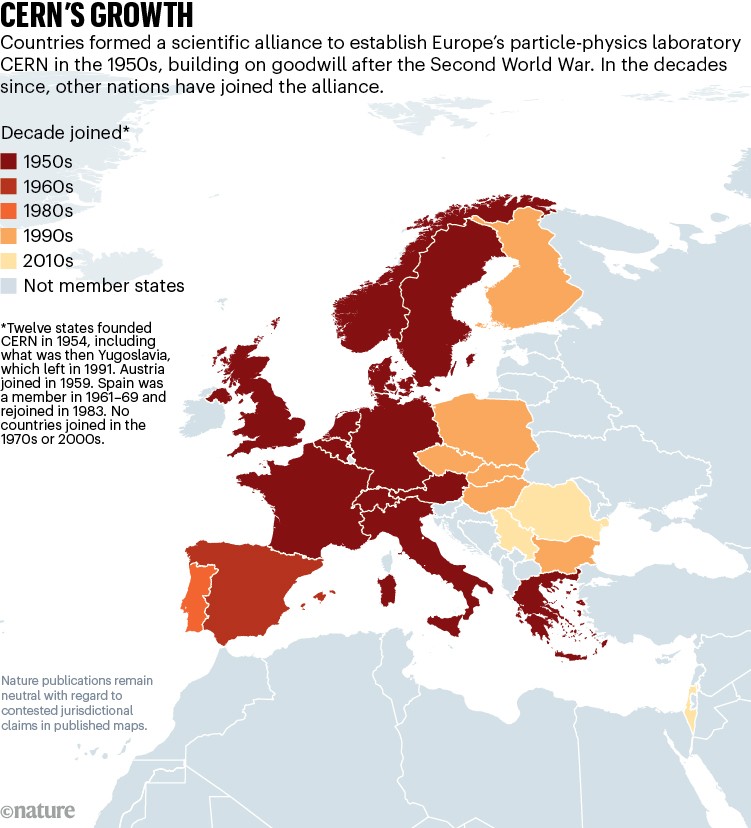
Source: CERN
Part of the decision to build CERN in Switzerland was the country’s central location in Europe and its neutrality during the war. In fact, CERN’s convention states, “The Organization shall have no concern with work for military requirements.”
“CERN has this aspect of science for peace,” says Rainer Wallny, a physicist at the Swiss Federal Institute of Technology (ETH) Zurich who chaired the Swiss Institute of Particle Physics in 2020–21. “You are not doing anything military related; you work for the curiosity.”
Now, CERN is governed by a council of 23 member states that provide financial contributions and make decisions regarding the organization’s activities, budget and programmes. CERN’s projected annual revenue for 2023 was 1.39 billion Swiss francs (US$1.53 billion), all of which it spends.“I think it is a great model for international collaboration,” says Wallny. “It has a lot of facilities available that are beyond the scope of individual user groups. No one has a particle accelerator in their backyard.”
The LHC, which is the most powerful particle accelerator in the world, consists of a 27-kilometre ring of superconducting magnets. Inside, two particle beams shoot trillions of protons towards one another at nearly the speed of light, causing some to collide and transform their energy into new particles. Along with the LHC, CERN has eight other particle accelerators, two decelerators, an antimatter factory and a vast array of engineering and computing infrastructure.
These resources bring together thousands of scientists from around the world to tackle big questions in particle physics. Research efforts at CERN led to the discovery of weak neutral currents in 1973, the W and Z bosons in 1983 and three types of neutrino in 1989 1 – 3 . These findings provided support for the standard model of physics, a theory developed in the 1970s that describes the fundamental particles of the Universe and the four forces that shape their interactions. Then, in July 2012, scientists at CERN found evidence for the last key force in the standard model — the Higgs boson 4 .
“I’m fascinated by the concept of having these large, international collaborations working on a scientific puzzle,” says Lea Caminada, a particle physicist at the University of Zurich and the Paul Scherrer Institute in Villigen, Switzerland. Caminada and her research group develop pixel detectors for the Compact Muon Solenoid (CMS), a particle detector experiment at the LHC that does research on the standard model, dark matter and extra dimensions. “Doing high-energy physics is unique. It’s really the energy frontier, and there is no other facility in the world where you can do this,” she says.
The CMS collaboration involves more than 5,900 physicists, engineers, technicians and students from 259 institutions across 60 countries. The collaboration publishes around 100 papers each year and celebrated its 1,000th publication in November 2020. But organizing and contributing to large-scale projects is no simple feat. “It’s not always easy to work at CERN. It’s very hard to organize experiments this big,” Caminada says. For instance, she explains, everyone involved in the CMS experiment can review manuscript drafts and provide feedback before submission of a paper. “But I think it creates opportunities for people in different countries.”
A fount of knowledge
Thea Klæboe Åarrestad’s first experience at CERN was during an undergraduate internship in July 2012. During the paid programme, she took three weeks of classes, met with fellow physicists and attended lectures from specialists in the field. It also happened to be the year CERN announced the discovery of the Higgs boson. “Peter Higgs was there. The press of the free world was there. People were sleeping in lines outside the main auditorium to catch the speech,” she says.
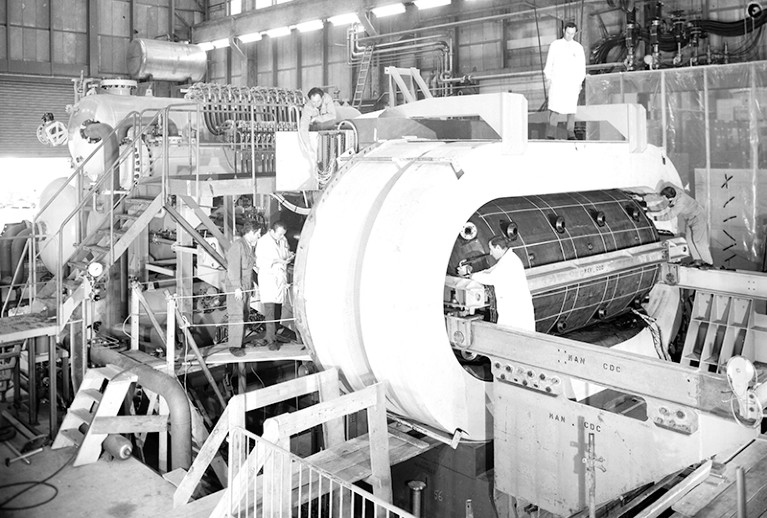
The Gargamelle chamber at CERN, operational during the 1970s, detected neutrinos. Credit: CERN PhotoLab
Åarrestad went on to earn her PhD from the University of Zurich in 2019, where she worked on the CMS experiment at CERN, and then became a research fellow at CERN from 2019 to 2021. “My daughter was five months old when I started commuting to CERN. I spent eight hours on the train every day,” she says. “My friends questioned whether I could do exactly the same work for a company, and I can honestly say no, I can’t.”
Now, as a particle physicist at ETH Zurich, Åarrestad studies how to use machine learning to improve data collection and analysis methods at CERN. “The environment there is fantastic. You go for a coffee and everyone has ideas and thoughts to discuss. I was always very passionate about physics, and being at CERN just made me even more passionate about it because I shared it with so many others,” she says.
Reverberating impacts
The impact of CERN goes well beyond the smashing together of tiny particles. “Such a vibrant intellectual node radiates out to the universities,” says Wallny. He often sends his graduate students to CERN, where they can gain experience in a large, international setting. “There’s a lot of education happening, and not just in science and engineering. You interact with people from other cultures and learn how to express yourself in English,” he adds.
According to Wallny, lessons from organizing large-scale collaborations at CERN can also be applied to other areas of science, such as quantum computing. “In these large experiments, you have to invent your own governance. You have a bunch of usually quite anarchistic academics who still have to play by some rules. You have to give yourself a constitution and a collaboration board. These approaches can easily be copied in other emerging fields of science,” he says.
Investing in projects such as CERN has benefits for society that expand beyond the bounds of academia. Massimo Florio, an economist at the University of Milan in Italy, calculates the costs and benefits of large-scale research infrastructure projects. In 2018, Florio and his colleagues evaluated how procurement orders from CERN for the production of the LHC affected knowledge production, patent filings, sales and profits for more than 350 supplier companies 5 .
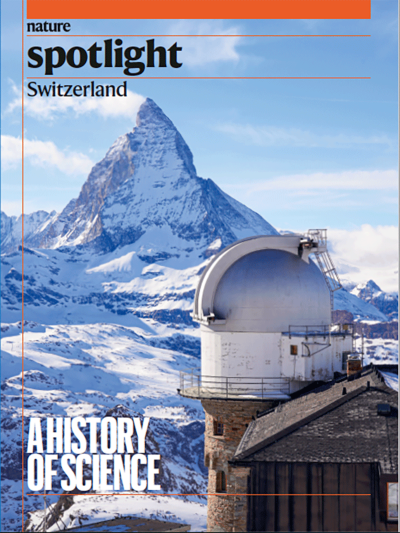
Nature Spotlight: Switzerland
“There is clear evidence that after they got an order from CERN, even 10 years later, it was transformative for them,” says Florio. “Even if you give zero value to the discovery of the Higgs boson, the knowledge generated along the way has immediate benefits to society.”
Over the past 70 years, technologies developed at CERN to tackle technical and computing challenges have been applied throughout the world. Perhaps the most notable is the World Wide Web, which was developed by computer scientist Tim Berners-Lee in 1989 to rapidly share knowledge among scientists. In medicine, the technologies from particle accelerators and detectors are used in positron emission tomography scanners and radiation methods for cancer treatments, such as hadron therapy 6 .
Satisfying curiosity
As CERN embarks on its eighth decade of research, the organization is planning to upgrade its accelerators to add to knowledge about the fundamental particles that make up the Universe. Towards the end of 2025, the LHC will be shut down and upgraded to a high-luminosity LHC over about four years. The upgrades aim to increase the machine’s luminosity tenfold, which would result in a larger number of collisions, allowing scientists to observe new events and rare events, such as those producing a Higgs boson, in more detail. “If we’re ever going to produce new physics, we need a lot of data. And in order to get a lot of data, we need more collisions,” says Åarrestad. She notes that upgrades to the LHC will result in almost quadruple the number of collisions that occur now.
Feasibility studies are also being conducted for the potential development of the Future Collision Collider (FCC), a massive, 91-kilometre particle accelerator 7 . A later phase of the proposed FCC is a hadron collider that could have roughly seven times the collision energy of the LHC. But there are concerns about the costs and environmental impacts of the FCC proposals 8 , as well as particle-physics research more broadly. “There are a lot of humans that would benefit from that money. It costs energy and affects the environment to do fundamental physics,” says Åarrestad. “But I think it is something we should continue in the future despite the cost and the energy consumption, because in the end, as humans, what are we if we’re not curious about where we’re from?”
Furthermore, says Pol, basic research often leads to real-world advances. “Sometimes, something new comes out of basic, theoretical research — one never knows. So, you have to give people who are really skilled a chance to try and find out what makes us what we are,” he says.
That sentiment holds for non-scientists, as well. While working on a contribution to the 2023 book Collisions: Stories from the Science of CERN , Lucy Caldwell, a novelist and playwright based in Ireland, had the opportunity to visit the organization. There, she met several scientists and published a fictional piece on the basis of her experiences. “As humankind, we tend to tell the same stories over and over in different variations,” she says. “Being able to go somewhere like CERN and talk to the scientists right at the cutting edge of knowledge gives you, as a writer, new images, new words and new concepts. It gives you ways to make old stories fresh again and ways to tell new stories. And I think that’s important for all of us.”
Nature 628 , S1-S3 (2024)
doi: https://doi.org/10.1038/d41586-024-01100-w
This article is part of Nature Spotlight: Switzerland , an editorially independent supplement. Advertisers have no influence over the content.
Haidt, D. in 60 Years of CERN Experiments and Discoveries (eds Schopper, H. & Di Lella, L.) 165–183 (Advanced Series on Directions in High Energy Physics, World Scientific, 2015).
Google Scholar
Di Lella, L. & Rubbia, C. in 60 Years of CERN Experiments and Discoveries (eds Schopper, H. & Di Lella, L.) 137–163 (Advanced Series on Directions in High Energy Physics, World Scientific, 2015).
Mele, S. in 60 Years of CERN Experiments and Discoveries (eds Schopper, H. & Di Lella, L.) 89–106 (Advanced Series on Directions in High Energy Physics, World Scientific, 2015).
The ATLAS Collaboration Phys. Lett. B 716 , 1–29 (2012).
Article Google Scholar
Castelnovo, P. et al. Res. Policy 47 , 1853–1867 (2018).
Dosanjh, M. et al. Front. Oncol. 6 , 9 (2016).
Article PubMed Google Scholar
Blondel, A. & Janot, P. Eur. Phys. J. Plus. 137 , 92 (2022).
Janot, P. & Blondel, A. Eur. Phys. J. Plus 137 , 1122 (2022).
Download references
Related Articles

Partner content: Claudin-1-targeted therapies break barriers in precision oncology
Partner content: Cutting-edge diabetes technology to make lives easier
Partner content: From wristwatches to comets and back again
Partner content: How do you know how a medical implant will behave before it's manufactured?
Partner content: Quantum-as-a-service is already solving industry problems
Partner content: The dawn of next-generation synthetic lethal drugs
- Particle physics
- Institutions

Scientists urged to collect royalties from the ‘magic money tree’
Career Feature 25 APR 24

The economic commitment of climate change
Article 17 APR 24

Revealed: the ten research papers that policy documents cite most
News 15 APR 24

Detectors deep in South Pole ice pin down elusive tau neutrino
Research Highlight 19 APR 24

Obituary 12 APR 24

A supercollider glimpses a gathering of three particles never seen together before
Research Highlight 21 MAR 24

Judge dismisses superconductivity physicist’s lawsuit against university
News 25 APR 24

Exclusive: official investigation reveals how superconductivity physicist faked blockbuster results
News 06 APR 24

Larger or longer grants unlikely to push senior scientists towards high-risk, high-reward work
Nature Index 25 MAR 24
Postdoctoral Fellowships: Early Diagnosis and Precision Oncology of Gastrointestinal Cancers
We currently have multiple postdoctoral fellowship positions within the multidisciplinary research team headed by Dr. Ajay Goel, professor and foun...
Monrovia, California
Beckman Research Institute, City of Hope, Goel Lab
Postdoctoral Research Fellow Positions, Division of Rheumatology
We seek two postdoctoral fellows to join the Mustelin/Najjar lab in the Rheumatology division, University of Washington, Seattle, USA, to lead and ...
Seattle, Washington State
University of Washington, Department of Medicine, Division of Rheumatology
Postdoctoral Associate- Computational Spatial Biology
Houston, Texas (US)
Baylor College of Medicine (BCM)
Staff Scientist - Genetics and Genomics
Technician - senior technician in cell and molecular biology.
APPLICATION CLOSING DATE: 24.05.2024 Human Technopole (HT) is a distinguished life science research institute founded and supported by the Italian ...
Human Technopole
Sign up for the Nature Briefing newsletter — what matters in science, free to your inbox daily.
Quick links
- Explore articles by subject
- Guide to authors
- Editorial policies

IMAGES
VIDEO
COMMENTS
Plan your visit Opening hours Accessibility Getting here PUBLIC EVENTS. Public events at CERN are organised with the support of the CERN & Society Foundation. Wednesday. 24 Apr /24. 18:00 - 20:00 ... The CERN Science Gateway project is made possible thanks to the generous support of its donors. Click below to discover them all.
If you are interested in visiting CERN, the world's largest particle physics laboratory, you can find all the information you need on this webpage. You can learn about the different types of visits, the booking process, the safety rules and the accessibility options. You can also explore the CERN Science Gateway, a new flagship project that will offer a unique experience of science and ...
If you visit on your own, with your family or friends our daily guided tours are offered on a first-come, first-served basis. Connect to our exclusive web app when arriving at Science Gateway to check guided tour availabilites and to register. Discover CERN's first accelerator, the synchrocyclotron, installed back in 1957.
See and do. We want our visitors to engage with CERN and science through authentic and inspirational experiences.
Accelerate: explore CERN's particle accelerators. Scientists from all over the world join forces at CERN to answer profound questions about the Universe. Let them guide you through the laboratory! An immersive scenography will transport you to the underground tunnels where the smallest building blocks of matter accelerate and collide.
The CERN logo is the property of CERN, and its use on any item produced by an external organisation is not permitted under any circumstances, including in the context of a school visit. However, the use of phrases such as "Visit to CERN, Geneva, Switzerland" is acceptable.
Those arriving at Geneva Cointrin airport can obtain a free bus and tram ticket from the machine in the baggage collection area of the arrivals hall. ... Our Discover CERN online page provides numerous resources for you to learn more about CERN before your visit. Which languages can I use to communicate with the Visits Service? French and ...
At CERN, we probe the fundamental structure of particles that make up everything around us. We do so using the world's largest and most complex scientific instruments. ... Plan your CERN visit video. image. ... 1211 Geneva 23; Switzerland; CERN & You. Doing business with CERN; Knowledge transfer; CERN's neighbours;
9. Park near the big dome. There's plenty of parking, or at least there was on the day of our visit, but you can't just park anywhere. The best place for you to park would be next to the big brown dome. Just east of the dome, towards the Swiss side of Cern, there is a big parking lot that's free to park at. 10.
A visit to CERN in Geneva is an exhilarating plunge into the fascinating world of particle physics. The sprawling facility, home to the renowned Large Hadron Collider, offers a captivating journey through the history and forefront of scientific discovery. The guided tour provides valuable insights into complex concepts, making them accessible ...
How to visit. CERN is a 25-minute tram ride from Geneva's city center, and some hotels may even offer free transport cards. The Science Gateway 's exhibitions are open Tuesday-Sunday 9 a.m.-5 p.m. (reception opens at 8 a.m.). Tours can be booked at the Science Gateway on a first-come, first-served basis.
CERN has a rich educational and cultural programme. As an integral part of this programme, tours of the Laboratory are free of charge. Find out more about CERN tours via visit.cern, which includes frequently asked questions about CERN tours. How to get to CERN. Preparing for your CERN visit
A visit to CERN in Geneva is an exhilarating plunge into the fascinating world of particle physics. The sprawling facility, home to the renowned Large Hadron Collider, offers a captivating journey through the history and forefront of scientific discovery. The guided tour provides valuable insights into complex concepts, making them accessible ...
About CERN. At CERN, we probe the fundamental structure of the particles that make up everything around us. We do so using the world's largest and most complex scientific instruments. Physicists and engineers at CERN use the world's largest and most complex scientific instruments to study the basic constituents of matter - fundamental particles.
Plan your visit Getting here Accessibility Opening hours PUBLIC EVENTS. Public events at CERN are organised with the support of the CERN & Society Foundation. Thursday. 18 Apr /24. 19:30 - 21:30 ... The CERN Science Gateway project is made possible thanks to the generous support of its donors. Click below to discover them all.
CERN. Cern, abbreviation for French name Organisation Européenne Pour la Recherche Nucléaire, meaning in English: The European Organization for Nuclear Research, is the biggest, most sophisticated physical research centers in the world, of high significance. It was build and is operated by joint efforts of 21 member countries. Guided Tours.
To schedule an onsite visit to the ATLAS experiment, please contact the CERN Visits Service.. The ATLAS Visitor Center has a permanent exhibit with interactive screens outside the Control Room and a 3D movie which explains how the detector works and why the collaboration pursues its quest for fundamental knowledge. CERN also has two permanent exhibitions Universe of Particles and Microcosm ...
About. CERN. At CERN, we probe the fundamental structure of particles that make up everything around us. We do so using the world's largest and most complex scientific instruments. Know more. Who we are. Our Mission. Our Governance. Our Member States.
How to get to CERN By plane From Geneva International Airport at Cointrin. Taxi: approximately 35 CHF. Public transport: take bus 23, 28 or 57 and get off at "Blandonnet" and then catch tram 18 or bus 68 to the final stop "CERN". See the TPG web site for full details. By train From Geneva railway station at Cornavin (Gare Cornavin)
On 29 September 1954, 12 member states signed a convention establishing CERN near Geneva (see 'CERN'S growth'). Source: CERN. ... had the opportunity to visit the organization. There, she ...